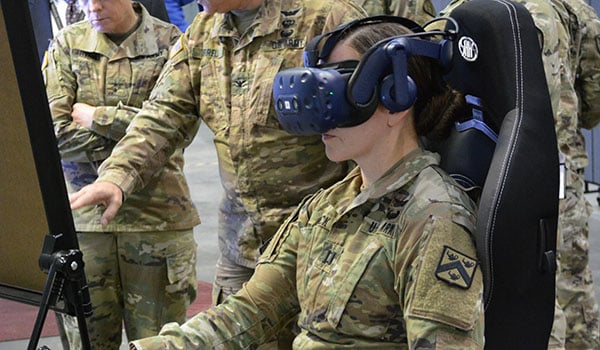
Branch Chief Update / By By MG David J. Francis: It is an honor for Jodie and me to sign on as your 17th Chief of the Aviation Branch. Our sincere gratitude to MG Bill and Michelle Gayler for their steadfast leadership of the branch over the last three years. MG Gayler set us on a path to maintain Aviation as an asymmetric advantage for our nation, and to develop and field leap-ahead capability in the future.

COL John Ferrell (center) briefs (left to right) Mr. Tim Bishop, Deputy PEO STRI; MG Maria Gervais, STE CFT Director; and MG William Gayler,
then-USAACE CG on the Aviator Training Next (ATN) Program while CPT Marisa Lock performs traffic patterns in a VR Black Hawk on June 4, 2019 at Ft. Rucker, AL. / U.S. ARMY COURTESY PHOTO
His pursuit of training the best Aviators in the world endures and is highlighted in this article featuring Aviator Training Next. Our best wishes to the Gaylers in their next assignment, and it is our honor to serve beside the outstanding Soldiers, DACs, and leaders of this branch.
As the Army recalibrates and reorients for Large Scale Combat Operations (LSCO), the way commanders will train must continue to adapt. This training evolution will impact both individual and collective training while leveraging the latest technology tools. The U.S. Army Aviation Center of Excellence (USAACE) Directorate of Simulation (DOS) continues to spearhead this transition into the future with two key initiatives: Aviator Training Next (ATN) and the Synthetic Training Environment (STE) programs. The implementation of these programs could fundamentally transform the way we train aviators during the Initial Entry Rotary Wing (IERW) course and provide aviation commanders more effective means for conducting collective training in a synthetic training environment at home station. ATN will test new approaches to train Aviators by introducing innovative commercial-off-the-shelf (COTS) technologies that have already matured to a level that can readily support Army training requirements. This, coupled with a better understanding of cognitive science, has potential to considerably improve student learning. Augmented and virtual reality capabilities will be key drivers for synthetic training in the future and USAACE will work to stay on the leading edge. ATN, which focuses on individual training, combined with the STE, will fundamentally transform the way we train to meet tomorrow’s challenges.
Aviator Training Next (ATN)
Beginning in July of 2019, USAACE will execute a series of IERW test programs at Fort Rucker, AL to assess the effectiveness of virtual reality (VR) flight training capabilities. USAACE intends to maximize modern technologies and advances in cognitive science to improve how we train pilots. The ATN concept is modeled on the Air Force’s Pilot Training Next (PTN) program and seeks to produce more proficient students by reinforcing basic pilot flight maneuver tasks. The program increases frequency and repetition through integration of additional VR training into the current program of instruction (POI) by using a training system consisting of a low-cost COTS virtual trainer and flight software, artificial intelligence/intelligent tutoring and cognitive measurement. In addition to scheduled POI training periods, students will have access to these training devices after hours and on weekends to practice more frequently.
The focus of the ATN program is within the Basic Army Aviator Course (BAAC) portion of IERW. Each pilot class will be divided into a control group and two test groups in order to determine the right mix of live / VR / simulation that results in increased proficiency in base tasks. The use of VR is introduced during ground school through the end of primary training and student progress will be measured through multiple live-flight check rides to capture analytics of proficiency, comprehension, and overall flight skill development as compared to the control group. The tasks being taught on the flight line will be reinforced with the VR systems which will allow students to practice maneuvers and be measured against the maneuver standard while being coached by an intelligent tutoring system that will measure the student’s performance and provide real-time and post maneuver feedback. The concept proposes that by gaining a higher level of proficiency in VR and simulation, instructors can maximize each live flight hour and focus on more warfighter skill development during later phases of IERW. This enhancement to the training of individual tasks will lay the foundation for a successful collective training environment as well.
Synthetic Training Environment
The Synthetic Training Environment (STE) capability will support Army collective training in a multi-domain battlefield. The STE will address the challenges of multi-domain training by providing a scalable environment (live, virtual, constructive, and gaming) of common characteristics that use common standards, architecture, terrain and authoritative data. The STE will provide the Army a usable, realistic, and complex training environment that improves readiness through increased repetition to achieve mastery of warfighting skills.
For Army Aviation, the STE will provide emerging technologies like mixed reality visual displays and artificial intelligence (AI) to expand and enhance training efforts. The envisioned end state will incorporate actual aircraft operational flight program (OFP) into the synthetic environment and will reach concurrency with fielded aircraft within 90 days. Additionally, the STE will be able to import Aviation Mission Planning capabilities in conjunction with the STE’s tools to preview, control, and assess training. To enable better training flexibility and to meet the commander’s needs, the STE trainer will be modular to the extent that it can be brought to various locations to support unique training or mission requirements, whether at the hangar, in a classroom or at a deployed location.
Above the Best!
MG David J. Francis is the Army Aviation branch chief and commander of the U.S. Army Aviation Center of Excellence and Fort Rucker, AL.








